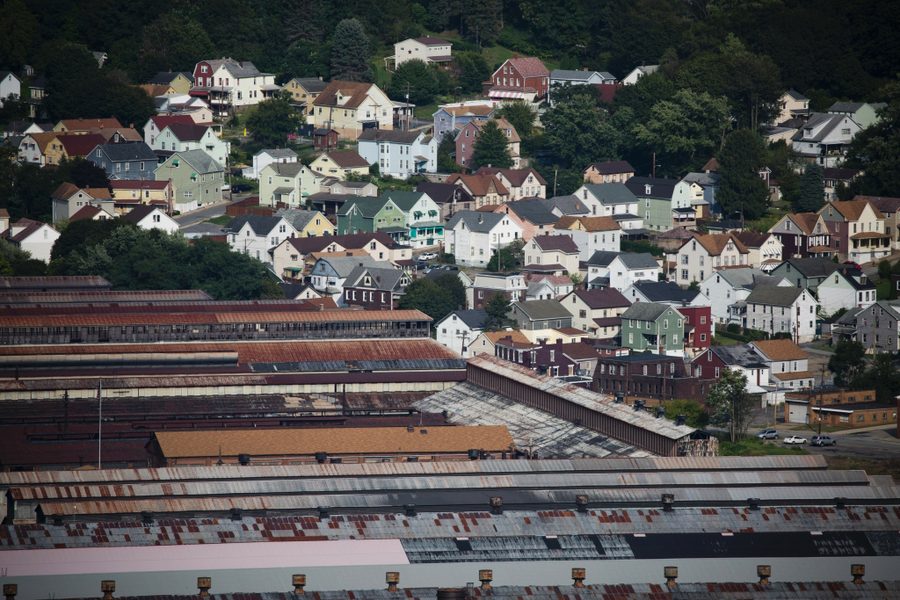Lost Jobs, Lost Democrats
Neoliberal Democrats are struggling to connect with working-class voters whose communities have lost manufacturing jobs.
Joel Bleifuss

Democrats have an electability problem in America’s industrial heartland that could flip the Senate red for a decade to come.
In a new study, “Factory Towns,” Iowa Democratic analyst Richard Martin examines the 853 counties of upstate New York, Pennsylvania, Ohio, Michigan, Indiana, Illinois, Missouri, Iowa, Wisconsin and Minnesota. He reports that 618 of these counties lost manufacturing jobs from 2001 to 2019.
Perhaps not coincidentally, between the 2012 and 2020 presidential elections, the 565 counties he designates “small and midsized manufacturing counties” saw a 2,635,000-vote net gain for GOP candidate Donald Trump. Add a 557,000 vote GOP gain from the 209 “rural counties” and that’s 3,192,000 votes in 2020 — which dwarfs the 1,188,000 Democratic-vote gain in the 79 “metro,” “college” and “suburban” counties from the study.
It’s likely that Trump won a significant number of votes in these economically anxious communities with promises to create factory jobs and to stand up to a Democratic elite that had shipped those jobs overseas (and was planning to again with the Trans-Pacific Partnership). Recall how, in the 1990s, the Clintonites and their Democratic Leadership Council buddies rewarded the corporate donor class with NAFTA, leaving displaced factory workers behind. Martin reports that, in the 382 manufacturing counties where Trump votes grew, 496,000 factory jobs were lost from 2001 to 2019.
From 2010 to 2020, the United States lost 462,000 union members; 93% of that decline came in nine of the states studied (upstate New York data was not available).
In the past two decades, Democrats have sought to forge a governing majority by winning the support of various (and overlapping) Democratic-leaning demographic groups: Latinos, African Americans, the highly educated, suburban women, union members, LGBTQ people and the Left (always as the junior partner and never in charge). In 2008 and 2012, that strategy maintained enough working-class white voters in the Midwest to secure former President Barack Obama’s victory. In 2016, Democrats lost the Electoral College when Trump carried eight states Obama had won in 2008 including Wisconsin, Michigan and Pennsylvania, swing states featured in “Factory Towns.”
With factory town residents moving toward the GOP — and considering the gains Trump made nationally among Black and Latino men, 19% and 36% of whom voted Trump, respectively — the future for Democrats looks bleak, especially if the Dems in the 117th Congress fail to deliver the goods.
The controversial Democratic political data analyst David Shor maintains that, should Democrats eke out 51% of the two-party vote in 2022 (which is unlikely, as the sitting president’s party usually suffers midterm losses), then they will lose one Senate seat and the Senate majority. With 51% of the vote in 2024, Shor — whose prognostications have proven surprisingly accurate — predicts Democrats will lose an additional six Senate seats.
An intervention seems necessary, and it should come not from the corporate Democrats who got us into this mess (by failing to pass legislation that concretely addresses people’s economic anxieties), but the party’s left wing (where actually popular bread-and-butter solutions are incubated, such as Medicare for All and jobs programs like the Green New Deal).
Unfortunately, some liberals, like the New York Times’ Jamelle Bouie, think it’s a fool’s errand to try flipping back formerly blue counties in the Rust Belt and Midwest, as if Obama-Trump voters are irredeemable, unreachable and unworthy of the effort.
A progressive coalition can win back the Rust Belt and other lost Democratic strongholds by addressing these factory-town workers not as a xenophobic, aggrieved demographic, but as part of a class—a struggling, anxious, racially and ethnically diverse group of people who understand that American society, as presently constituted, is not designed to ensure their wealth, health or happiness.
Joel Bleifuss, a former director of the Peace Studies Program at the University of Missouri-Columbia, is the editor & publisher of In These Times, where he has worked since October 1986.









